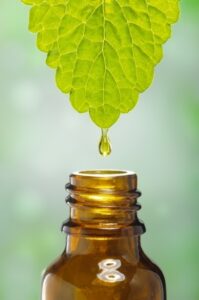Essential oils are extracted from the aromatic essences of certain plants, trees, fruit, flowers, herbs, and spices. They are natural, volatile oils with identifiable chemical and medicinal properties. Over 150 essential oils have been extracted, each one with its own scent and unique healing properties.
Despite considerable research, the chemistry of essential oils is not fully understood. Each oil is composed of at least 100 different chemical constituents. The oils and their actions are extremely complex. All the oils are antiseptic, but each one also has individual properties; for example, they may be analgesic, fungicidal, diuretic, or expectorant. The collective components of each oil also work together to give the oil a dominant characteristic. It can be relaxing, as in the case of chamomile, refreshing, like the citrus grapefruit, or stimulating, like the aromatic rosemary.
Within the body, essential oils are able to operate in three ways: pharmacologically, physiologically, and psychologically. From a pharmacological perspective, the chemical components of the oils react with the body chemistry in a way that is similar to drugs, but slower, more sympathetic, and with few side-effects. Essential oils also have notable physiological effects. Certain oils have an affinity with particular areas of the body. For example, rose has an affinity with the female reproductive system, while spice oils tend to benefit the digestive system. The oil may also sedate an overactive system, or stimulate a different part of the body that is sluggish. Some oils, such as lavender, are known as adaptogens, meaning they do whatever the body requires of them at the time. The psychological response is triggered by the effect that the aromatic molecules have on the brain.
Applications and Uses of Essential Oils
- Diffusion is when the oil is released into the air. This may be done with air diffusers or by putting 10-12 drops in a spray bottle with water, shaking vigorously, and spraying around a room.
- Topically, oils may be applied over the area of complaint. The bottoms of the feet and ears are also good for application because of the large number of acupuncture points in those areas of the body.
- Inhalation is when the oil is directly breathed in through the nose. This allows the oil to be directly absorbed into the brain through the first cranial nerve (olfactory nerve). This should typically be done in conjunction with any other application in order to speed the effects of the oil in the body through neurological stimulation. Inhalation of some oils can lead to headaches, so start with light inhalation.
For more information please see our ESSENTIAL OILS PAGE.
